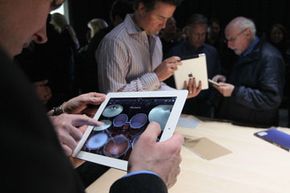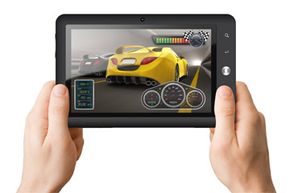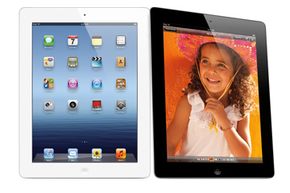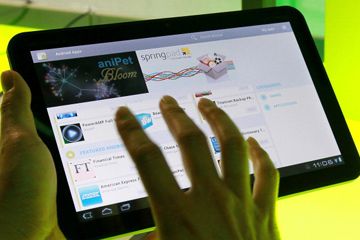The obvious competitor to the Android MID is the iPad. Apple leads the pack in tablet market share by a long shot, and is a leader in quality. Their devices are well designed and constructed, and have access to a host of applications vetted by Apple through iTunes. But there are Android tablets that rival the iPad, with solid construction, sharp graphics and a multitude of connection ports that the iPad is missing. And Android (like most Linux distributions) is less confining than Apple's proprietary OS.
Android doesn't have as many available applications as Apple. But there are tens of thousands to choose from. Productivity apps are one area where Android has a bit of an edge on iPad as far as selection. The allowance of widgets gives some apps a little more functionality on the Android side. And some Google-specific apps like their Maps program are improvements over the iOS versions. But there are far fewer games and other similar entertainment applications to choose from for Android, and they vary greatly in quality and device compatibility.
Android has some decided advantages, like allowing you to run multiple applications at a time, add widgets to customize your home screen (for things like social networking streams), replace the keyboard function with a different app, or run your choice of e-mail program or Web browser. For the most part, unfortunately, the tablets that come close to rivaling the iPad in quality are equally expensive. And the cheaper choices often have drawbacks.
The capabilities and the quality levels of the various Android MIDs vary wildly. The reviews of the more affordable devices like those manufactured by Coby and ViewSonic contain complaints about things like sluggishness when Web surfing, cheap materials, issues with some file formats not working and lack of access to the official Google app store. But they also get some good marks for video play back and general usability, and all sound like they make passable e-readers. But many of them cannot be upgraded to newer Android OS versions, further limiting their functionality. The incredibly cheap ($100 or less) no-name devices get much worse reviews with complaints about slowness, bugginess and poor video quality. And cheaper devices with older processors will not run applications very smoothly or quickly. With MIDs, the old adage "you get what you pay for" is as true as ever.
The tier of storage space you select will also make a difference in your experience. You may find yourself running out of room for apps and music rather quickly if you opt for a device with 8GB or less of flash memory. The connectivity methods or ports the device has will alter its usefulness, as well. Many Android devices have ports that allow for adding extra storage, streaming to your TV and getting data to or from your device from other devices (say, hooking directly to a camera rather than being forced to use a desktop application as an intermediary). With the iPad, aside from the headphone jack, there is one built-in proprietary connector.
The Google Nexus 7 device might prove to be an exception to the price versus quality tradeoff, at $200 or $250, depending upon whether you choose the 8GB or 16GB model. It's well reviewed so far, but it lacks some useful features like an HDMI port and rear-facing camera. It's also the first device to run the latest Android OS, 4.1 Jelly Bean. This version includes support for some pretty advanced features, like Android Beam, which allows you to share data by holding two Android devices back to back.
The version of the Android OS that you're running creates potential for differences in quality. There are security issues with the older versions of Android, and releases below 3.0 were made to handle smartphone sized screens, not larger tablets. The differences in OS versions, along with fragmentation in the available hardware and the different proprietary app markets, also lead to a decrease in selection of applications. Not all apps work on all devices. Many were created for ARM architectures and won't run on MIPS, for instance, and apps made for Android 4.0 might not run on 2.3. Google Play is apparently supposed to show you apps that would work on the device with which you connect, but this is reportedly not always the case.
The cheapest MIDs are often running earlier releases, mostly Android 2.2. or 2.3, and as mentioned earlier, many cannot be upgraded. The vast majority of Android devices in the wild around February 2012 were running Android 2.3.3 or 2.2, with less than 5 percent running 3.0 or above [source: Gold]. There has been some improvement, with August 2012 figures showing instances of Android 4.0 up to around 16 percent and 4.1 at nearly 1 percent, but 2.2 and 2.3 are still in the majority with over 76 percent of distribution [source: Android Developers]. These figures include tablets and phones, but it still means that the majority of MIDs in the wild are running outdated and potentially insecure versions of the OS. This will change over time as the older devices are replaced and more and more new ones are made to run newer flavors of Android.




